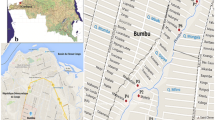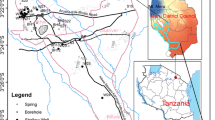Abstract
The variability of water quality due to fecal coliform bacteria among shallow wells (37–67 m deep) in Aba northwest and Owerri west flank of the Imo River basin Nigeria surpassed surface explanation. This is because the communities have similar human and animal waste disposing habit. Analytical results show that six out of ten wells (60%) have 40–70FC/100 ml of water exceeding the 10FC/100 ml of water allowable by the world health organization (WHO). The pollution is attributed predominantly to the absence of toilet facilities in automobile mechanic villages, and transit grazing of cattle in the area. Uphole refraction and vertical electric sounding revealed presence of highly weathered topsoil to an average depth (18 m), often with gravel bed. Water table is 16–21 m, fluctuating below and above the weathered base. Results implicate the coliform polluted shallow wells as those located in areas where water table (WT) is above weathered base and coincides with the base of “khaki” colored gravel bed. As a result, safe depth of shallow wells is obtained as: WT+48 m at locations were weathered base is above WT, and WT+66 m at locations were weathered base is below WT, for a total cased depth ranging from 60 m (200 ft) to 85.4 m (280 ft). In the absence of adequate treatment, the polluted wells may be closed. Auto mechanic villages without toilet facilities, transit grazing near streams and residential areas, poorly constructed septic tanks may be prohibited by law, and the practice of mechanic villages’ concept must be environmentally friendly to be sustainable.
Similar content being viewed by others
References
Adekunle AS, Eniola ITK (2008) Impact of industrial effluents on quality of segment of Asa river within an industrial estate in Ilorin, Nigeria. NY Sci J 1(1):17–21
Adekunle IM, Adetunji MT, Gbadebo AM, Banjoko OB (2007) Assessment of groundwater quality in a typical rural settlement in Southwest Nigeria. Int J Environ Res Pub Health 4(4):307–318
Ajayi AA, Sridhar MKC, Adekunle LV, Oluwande PA (2008) Quality of packaged waters sold in Ibadan, Nigeria. Afr J Biomed Res 11(3):251–258
Comely HH (1987) Cyanosis in infants caused by nitrates in well water. J Am Med Assoc 257:2788–2792
Crane SR, Moore JA (1984) Bacterial pollution of groundwater: a review. Water Air Soil Pollution 22(1):67–83
Dobrin MB, Savit CH (1988) Introduction to geophysical prospecting, 4th edn. McGraw-Hills, New York
Ejechi EO, Ejechi BO (2007) Sociological dimensions in the handling habit and sanitary quality of hand-dug well water from oil-producing area of Nigeria. J Environ Monit Assess. 134:255–261
Ekwe AC, Onu NN, Onuoha KM (2006) Estimation of aquifer hydraulic characteristics from electric sounding data: the case of middle Imo river basin aquifers, SE Nigeria. J Spat Hydrol 6:2
Enikanselu P (2008) Geophysical seismic refraction and uphole survey analysis of weathered layer in the “Mono” field, North Western Niger Delta, Nigeria. Pac J Sci Technol 539(9):2
Falk RL, Ward WC (1957) Brazo River Bar: study of the significance of grain size parameters. J Sediment Petrol 5:3–26
Feachem R, McGarry M, Mara D (1977) Water, wastes and health in hot climates; book review. Trans R Soc Trop Med Hyg 71(5):443
Foster SSD, Hirata R (1988) Groundwater pollution risk assessment: a methodology using available data. WHO/PAHO-CEPIS Technical manual, Lima, Peru
Gonzales TR (2008) The effects that well depth and wellhead protection have on bacterial contamination of private water wells Estes Park Valley. Colorado J Environ Health 71
Ibiebele DD, Sokari TG (1989) Occurrence of drug-resistant bacteria in communal well water around Port-Harcourt, Nigeria. J Epidemiol Infect 103:193–202
Jha PK (2007) Sustainable technologies for waste management Retrieved from: http//:www.ias.unu.edu/proceedings/icibs/ecosan/jha-d1, 10/24/2009
Lateef JKO, Gueguimkana EB (2005) The prevalence of bacterial resistance in clinical, food, water and some environmental samples in southwest Nigeria. Springer J Environ Mon Asses 100:59–69
Mallin MA, Burkholder JM, McIver MR, Shank GC, Glascow HB, Touchette BW Jr., Springer J (1997) Comparative effects of poultry and swine waste lagoon spills on the quality of receiving waters. J Environ Qual 26:1622–1631
Njemanze PC, Anozie JO, Ihenacho JO, Russel MJ, Uwaeziozi AB (1999) Application of risk analysis and geographic information system technologies to the prevention of diarrhea diseases in Nigeria. Am J Trop Med Hyg 61(3)
Nwachukwu MA (2003) Determination of weathered layer by up-hole shooting technique within Owerri, NE Nigeria. Glob J Geol Sci 2(1)
Nwachukwu MA (2008) Environmental sanitation enforcement and compliance best management strategies for Nigeria. In: Proc INECE 8th international conference, 5–11 April 2008, Cape Town, South Africa, Track A
Nwachukwu MA, (2004) Alluvial mining and the sedimentary cycle- a stream sediment analysis review. Am Soc Min Metall Explor Trans 316:37–42
Nwachukwu MA, Feng H, Alinnor J (2010a) Assessment of heavy metal pollution in soil and their implications within and around mechanic villages. Int J Environ Sci Technol 7(2):347–358
Nwachukwu MA, Feng H, Achilike K (2010b) Integrated study for automobile wastes management and environmentally friendly mechanic villages in Imo River basin, Nigeria. Afr J Environ Sci Technol 4(4), in press
Olabisi OE, Awonusi AJ, Adebayo OJ (2008) Assessment of bacterial pollution of shallow well water in Abeokuta, Southwestern Nigeria. Life Sci J 5(1):59–65
Onyeagocha AC (1980) Petrography and depositional environment of the Benin Formation. Nig J Mining Geol 17:147–11
Richard F, McGarry M, Mara DW (1977) Waste and health in hot climates. Wiley, New York
Telford WM, Geldart LP, Sheriff RE (1990) Applied geophysics. Cambridge University Press, Cambridge
U.S. Department of Transport (U.S. DOT 2004); Federal highway administration: application of geophysical methods to highway related problems. Pub. No FHWA-IF-04-021 (2004)
Wisconsin Department of Natural Resources, Bureau of Drinking Water and Groundwater (2005), Bacteriological contamination of drinking water; PUB-DG-003-2005, retrieved 6/16/2009. www.uwsp.edu/cnr/gndwater/privatewells/Bacterialogical/Contamination
Author information
Authors and Affiliations
Corresponding author
Rights and permissions
About this article
Cite this article
Nwachukwu, M.A., Feng, H., Amadi, M.I. et al. The Causes and the Control of Selective Pollution of Shallow Wells by Coliform Bacteria, Imo River Basin Nigeria. Water Qual Expo Health 2, 75–84 (2010). https://doi.org/10.1007/s12403-010-0025-4
Received:
Revised:
Accepted:
Published:
Issue Date:
DOI: https://doi.org/10.1007/s12403-010-0025-4




